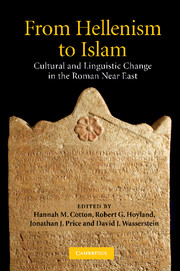Book contents
- Frontmatter
- Contents
- List of figures
- List of tables
- List of contributors
- Preface
- List of abbreviations
- Introduction: documentary evidence, social realities and the history of language
- Part I THE LANGUAGE OF POWER: LATIN IN THE ROMAN NEAR EAST
- Part II SOCIAL AND LEGAL INSTITUTIONS AS REFLECTED IN THE DOCUMENTARY EVIDENCE
- Part III THE EPIGRAPHIC LANGUAGE OF RELIGION
- 7 ‘Languages’ and religion in second- to fourth-century Palestine: in search of the impact of Rome
- 8 The epigraphic habit and the Jewish diasporas of Asia Minor and Syria
- 9 Religion and language in Dura-Europos
- Part IV LINGUISTIC METAMORPHOSES AND CONTINUITY OF CULTURES
- Part V GREEK INTO ARABIC
- Index
7 - ‘Languages’ and religion in second- to fourth-century Palestine: in search of the impact of Rome
Published online by Cambridge University Press: 01 March 2010
- Frontmatter
- Contents
- List of figures
- List of tables
- List of contributors
- Preface
- List of abbreviations
- Introduction: documentary evidence, social realities and the history of language
- Part I THE LANGUAGE OF POWER: LATIN IN THE ROMAN NEAR EAST
- Part II SOCIAL AND LEGAL INSTITUTIONS AS REFLECTED IN THE DOCUMENTARY EVIDENCE
- Part III THE EPIGRAPHIC LANGUAGE OF RELIGION
- 7 ‘Languages’ and religion in second- to fourth-century Palestine: in search of the impact of Rome
- 8 The epigraphic habit and the Jewish diasporas of Asia Minor and Syria
- 9 Religion and language in Dura-Europos
- Part IV LINGUISTIC METAMORPHOSES AND CONTINUITY OF CULTURES
- Part V GREEK INTO ARABIC
- Index
Summary
Ut liceat Hebraeis qui volunt … graeca lingua sacros libros … legere vel etiam patria forte (hac scilicet latina) vel omnino reliquis.
Justinian, Nov. 146, IThe Novella of 553 CE, if seen from a political viewpoint, dates from a centralised era and an Empire that was by and large Christian. And yet it attests to a multilingualism that was a characteristic of the Roman Empire at all periods even in the public realm. Given this fact, linguistic data documented by inscriptions could serve as just one way of evaluating the impact of Rome on local pagan practices in second- to fourth-century Palestine. The questions that this issue arouses go beyond the current theoretical debate about ‘Romanisation’. That has many aspects, of varying significance depending on the particular issue that is addressed, whether juridical, social or cultural. This paradigm, long dominant in studies of Roman provinces, was based on two prejudices: first, a colonial-like con-flict category (Romans vs. natives), and second, a preconceived idea of verticality combined with uniformity when studying the governance of cultural procedures. It has been applied mainly to western situations, but, even there, the term is so protean and coloured by historiography that S. Alcock (following other scholars) announced its fall a few years ago! For research on eastern provinces, the concept is even less accurate, because realia, possibly resulting from an actual ‘Roman’ impact, are generally embedded within Hellenistic trends that have a strong legacy in those areas. Yet this should not prevent us from asking about the impact of Rome on local paganisms, if there was any, and from trying to draw methodological lines in order to clarify the process.
- Type
- Chapter
- Information
- From Hellenism to IslamCultural and Linguistic Change in the Roman Near East, pp. 177 - 202Publisher: Cambridge University PressPrint publication year: 2009
- 1
- Cited by



